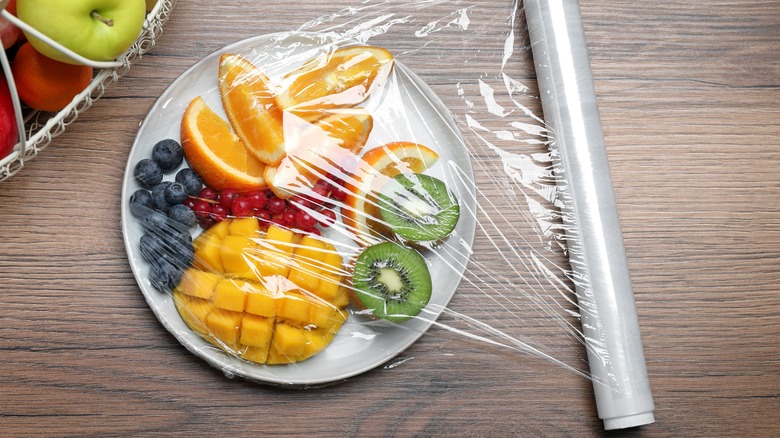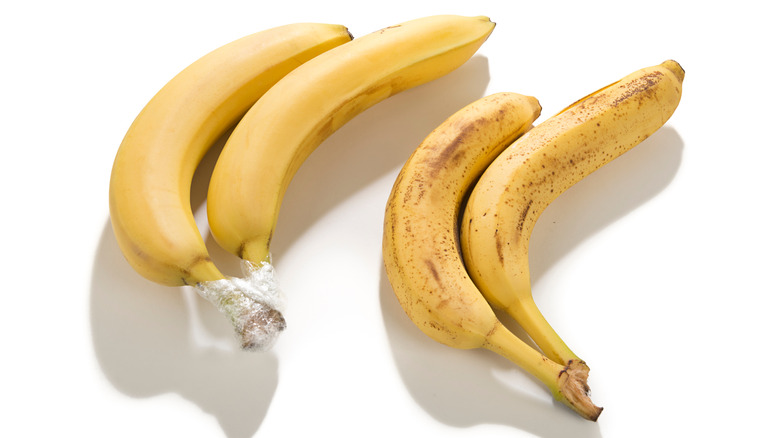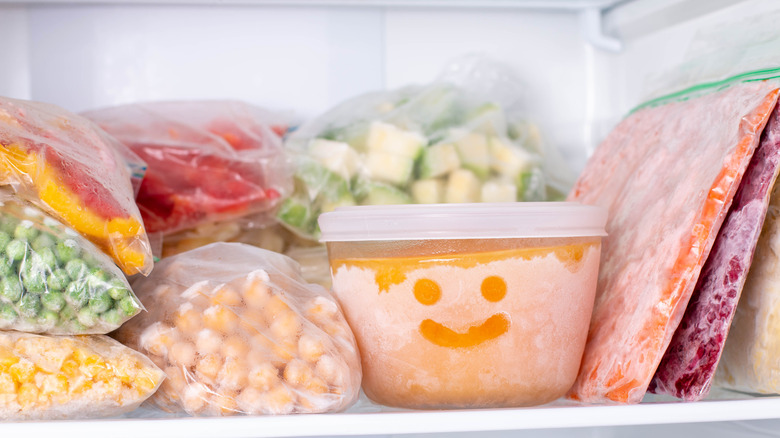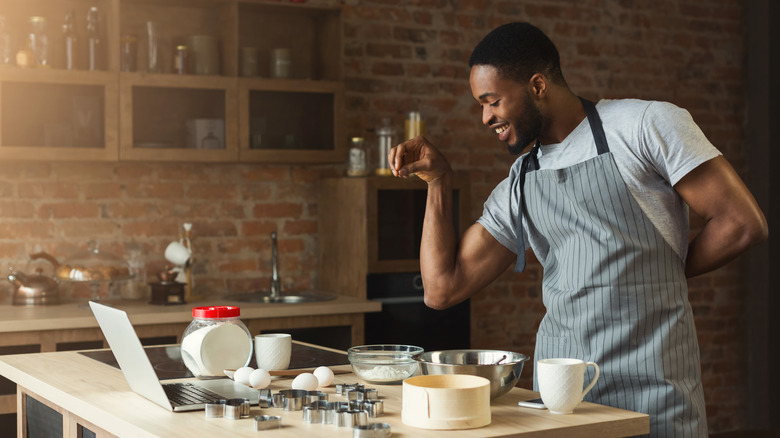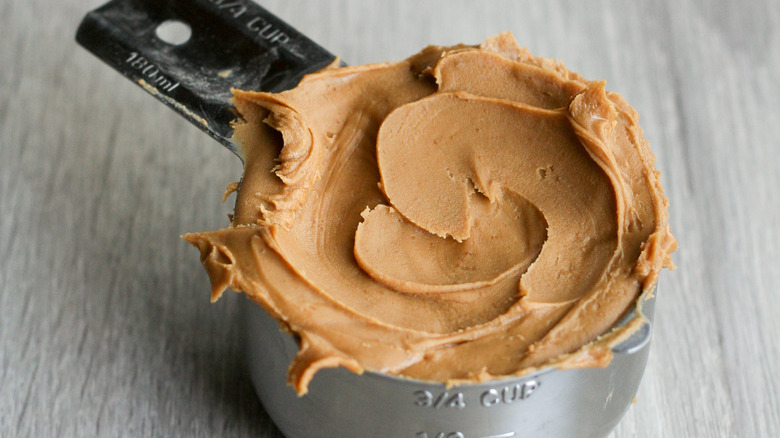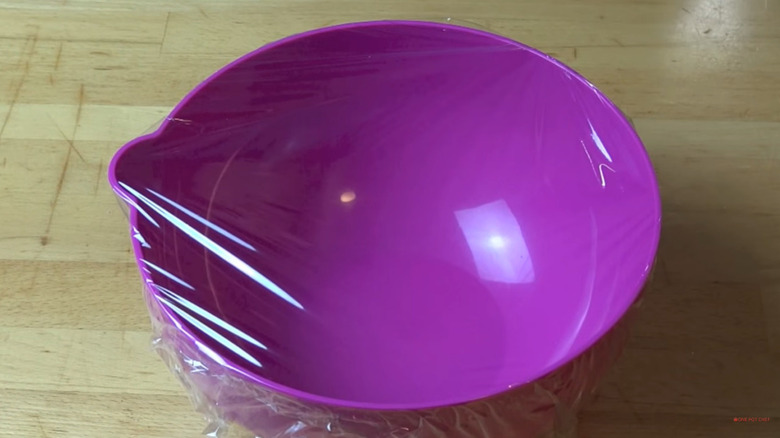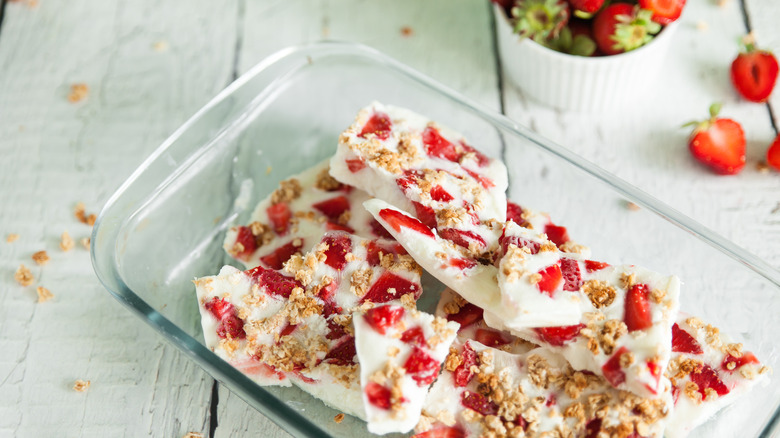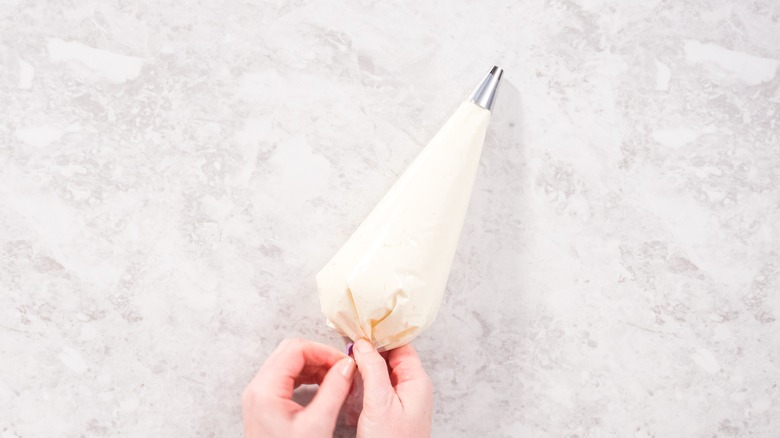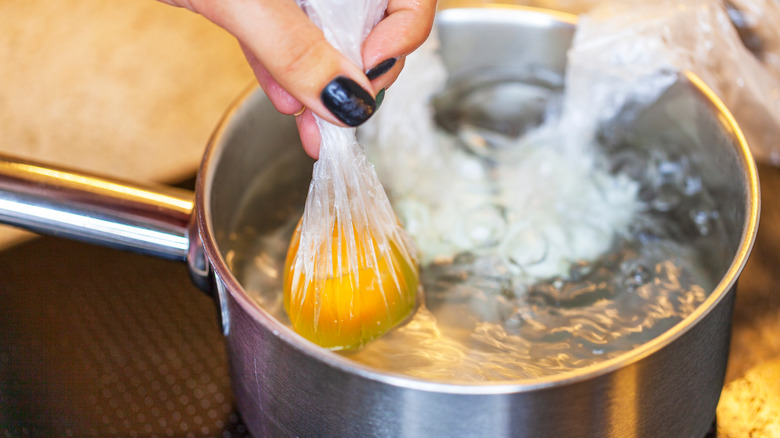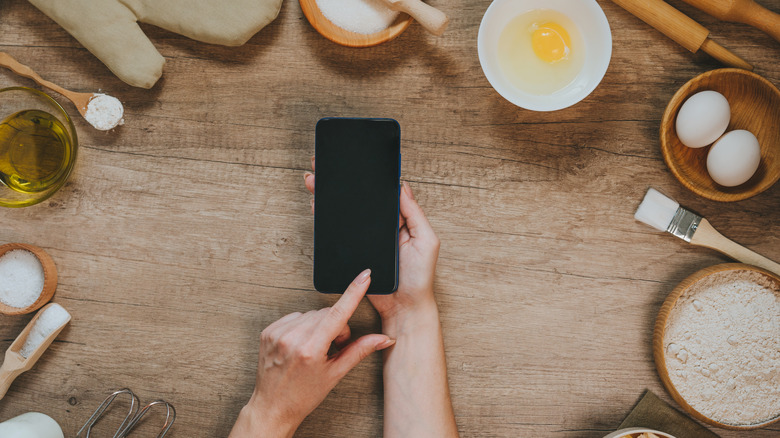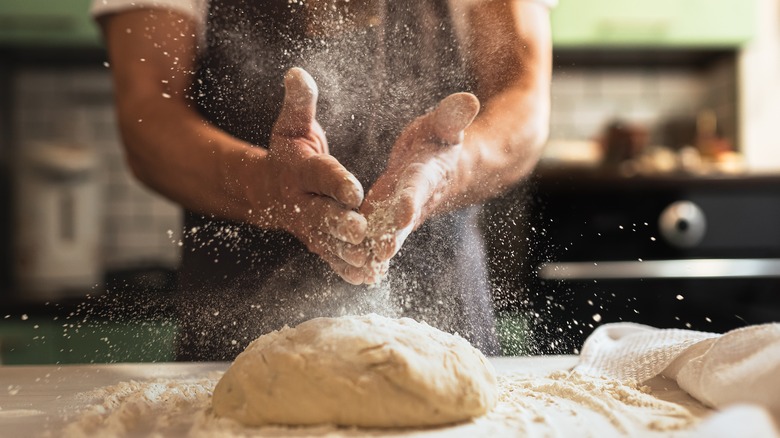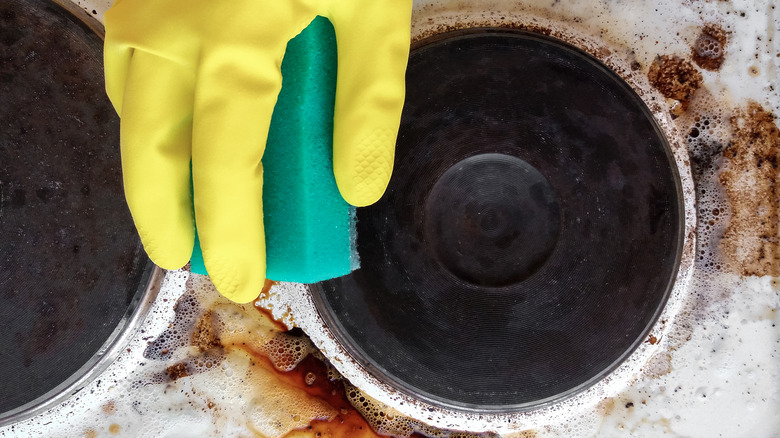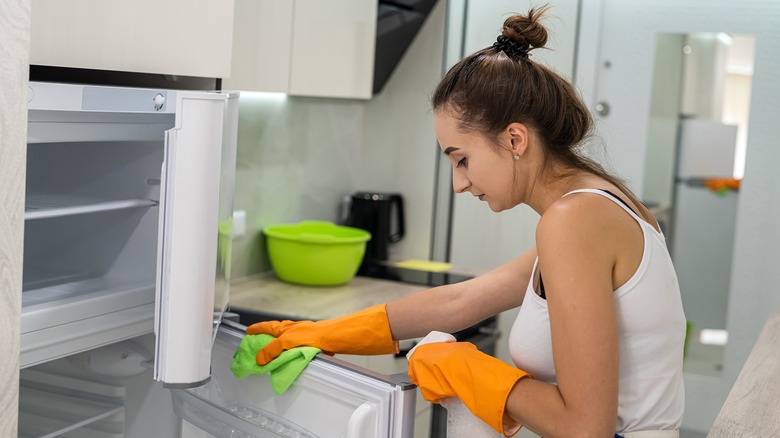12 Clever Ways To Use Plastic Wrap
Stowed away in a drawer in almost every kitchen, plastic wrap is most often used for... well, wrapping things. It keeps food fresh, clings mainly to itself, and now comes with an easy-to-use sliding cutter so you don't have to rip and tear away at it until giving up altogether and opting for a food storage container instead. Basically, plastic wrap can be the bane of your existence or it can become a life-changing hack for easy cleanup tricks, baking tips, and even some fun with science.
There are many ways that plastic wrap can save time, make kitchen tasks more manageable, and minimize other kinds of waste –- like food waste. According to the USDA, around 30 to 40% of the food supply is wasted in America. While some of this waste happens at the retail level, consumers also contribute to the loss of food. We can help prevent some of this waste simply by improving our storage techniques at home and keeping food fresh longer, which is where plastic wrap can be useful. But beyond eliminating waste, there are also many other clever ways to use plastic wrap.
1. Keep bananas fresh and other fruits ripe
Guilty of holding onto bananas because you swear you're going to make banana bread and then you toss them, mushy and brown, into the trash? While over-ripe bananas are the sweetest and most optimal choice to bake banana bread, wrapping plastic wrap around the stems is a simple way to keep them fresh longer. This method can reduce food waste, ultimately save money, and let's face it –- despair.
Bananas tend to ripen quickly because they contain a plant hormone called ethylene. The theory behind this trick is that wrapping the stems will slow down the ripening process by keeping that gas trapped inside. In a similar concept, tightly wrapping avocados (another ethylene-producing fruit) in plastic wrap after they've been cut can keep them from browning as quickly.
Inversely, plastic wrap can also encourage certain fruits to ripen, such as apples, mangoes, avocados, melons, and pears, which are receptive to the ethylene gas because they also release it. The gas travels through the fruits, triggering their defense responses, which speeds up the ripening process. The next time you want your peach or mango to ripen to that sweet spot, put it in a bowl with a banana, cover it with cling wrap, and let science do its work.
2. Prevent freezer burn
When storing food in freezer bags, it's difficult to get all of the air out, which often results in freezer burn. As soon as air touches something trying to freeze, it dehydrates and causes freezer burn. Although the FSIS states that this doesn't make the food inedible, it also notes that "Heavily freezer-burned foods may have to be discarded for quality reasons." To avoid food waste, try wrapping the food in plastic wrap before putting it in a freezer bag or plastic container. This is a great trick for meats, leftovers, and ice cream.
To keep your ice cream fresh and free of ice crystals, take off the lid, cover the container with plastic wrap, and put the lid back. By creating this seal, you are keeping out air with an extra layer of protection. For leftovers, cover the dish with plastic wrap first and then cover with aluminum foil or put it in a freezer-safe bag. Because liquids expand as they freeze, leave ½ an inch of free space at the top of the container when storing soups, then press down on the cling wrap gently before putting on the lid.
3. Make cleanup a snap
If you're like many of us, you get dry seasonings everywhere when you cook. Thanks to Salt Bae, seasoning with flair is now a trendy technique. Seasoning from higher up can distribute the seasonings more evenly. A few inches won't cut it — for better flavor, sprinkle seasonings from 8 to 12 inches above the food. To prevent a big mess, cover your kitchen counter with cling wrap before prepping your food. Less wiping and cleaning can save a lot of time during busy cooking nights.
Or next time you peel potatoes, cover the counter with plastic wrap first. When you're finished, pull the wrap off the counter and toss all of the skins and plastic into the bin. By using this trick, you'll avoid peeling potatoes over the sink and risking the skins going down the disposal.
It may seem like a lot of plastic wrap, but in some cases, it can be reused or even recycled. If it didn't rip or touch anything raw, plastic wrap can be wiped clean and used again, especially in times like this when you're using it for prepping veggies or dry ingredients.
4. Avoid sticky messes in measuring cups
Finally tried that too-good-to-ignore chocolate peanut butter banana bread recipe and now you're left with measuring cups that are filled with gooey ingredients and a huge mess? Save yourself some time and energy during your next peanut butter dessert fix and let plastic wrap do the work for you. For sticky ingredients like nut butter, honey, cream cheese, or even pesky ones like oil, line your dry measuring cups with plastic wrap before adding them.
It's also handy when you're using one dry measuring cup for multiple ingredients in a recipe. Sticky or slick ingredients stay on the surface of a measuring cup, so when you need that same amount of flour, you're left with a caked mess. By lining the cups, you'll prevent the build-up and having to rinse out the measuring cup while cooking. When it's time to switch ingredients or clean up, just toss the plastic wrap. In addition to making things a little easier, you'll also save space in the dishwasher instead of filling that top row with measuring cups that always seem to slip through the cracks or fill with water.
5. Line baking ware
TikTok user @thecaketoonist is here to save us all time and trouble the next time we mix batter or bake a loaf. For recipes that call using a mixing bowl, line the bowl snugly with plastic wrap by using water. Start by placing the plastic wrap in the bottom of the bowl, with a decent overhang on the rim of the bowl. Slowly fill the base with water, and then let loose the sides of the plastic wrap. This will start creating a seal, and as you keep pouring water to the top, it'll aid the plastic wrap in gripping the sides nice and tight. Make sure to pour slowly, and keep a hold of that overhang while loosening the sides. Let it sit for a while, then pour the water out. The result is a near-perfect lined bowl, which will save cleaning time and reduce mess when mixing batters.
When you need to line a metal tin, wet the bottom of it before putting the plastic wrap on it. Then follow the same steps as before, slowly filling with water and loosening the plastic wrap along the sides as you pour. Leave the water in the tin a little longer, and when you empty it out, it'll be lined and ready.
6. Make frozen yogurt bark
Frozen yogurt bark is a healthy and easy snack to make, and it can be personalized to your taste. Make the cooking process easier by wrapping your baking sheet with plastic wrap before spreading yogurt onto it. While parchment paper is a great option for this recipe, the plastic wrap won't slide around as much when you're spreading the yogurt, and it'll still prevent it from sticking after it's set. Add a combination of ingredients like berries or other fruit, granola or nuts, chia seeds, or bits of chocolate to the yogurt. Swirling jam or peanut butter through it is another great way to add flavor and texture.
After adding all the tasty ingredients, cover the yogurt with another layer of plastic wrap and pop it in the freezer until it sets. The frozen yogurt can be broken apart into chunks that are perfect for hot summer days when you need a sweet, but healthy, treat. Because they can melt if left at room temperature for too long, store the leftovers in the freezer in a container covered with plastic wrap.
7. Fill a piping bag quickly
While they are a wonderfully-convenient creation, piping bags are not always easy to fill. They save a lot of time when it comes to decorating or handling batter, like for macarons, but the struggle of getting the mix into the bag can be challenging and oftentimes rather messy. Scooping and spreading icing into a haphazardly folded bag is a gooey mess, but there is an easier way to get that stubborn icing in there.
Like they say: Work smarter, not harder. Next time you use a piping bag, roll out a slab of plastic wrap, put the icing directly on it, and then roll it up burrito-style before placing the entire thing in the piping bag. Squish it down to the bottom (this way the icing doesn't spill over the top when you start piping it), to fill the piping bag quickly and avoid a lot of the mess.
Another trick is to spread three rows of icing onto the plastic wrap in different colors. Then roll it up, and when you start piping, you have a swirl of color for the top of your cupcakes. TikTok user @aliwalkerxo demonstrates this technique to create pink roses on cupcakes.
8. Poach an egg
This plastic wrap hack will produce perfectly poached eggs easily and quickly. If you want to skip eating out and make a delicious brunch recipe at home, this simple trick will also impress your friends or family with your chef-like skills. Ready those mimosas, get that water boiling, whip up that hollandaise, and prepare for a tasty Eggs Benedict in little time.
In this YouTube video, Alexis Gauthier demonstrates just how fast you can poach an egg by using plastic wrap. The chef explains that you should line a cup, bowl, or ramekin with plastic wrap and leave quite a bit of overhang. Crack an egg into it, then create a little pouch by gathering the plastic wrap, twisting, and tying it off. Finally, drop the bag in boiling water for 4 minutes to ensure a fully cooked egg. After it's cooked, gently cut or tear the plastic wrap to avoid breaking it, and you've successfully poached an egg in under 5 minutes with this clever technique.
9. Prevent splattering on your phone
When you're scrolling through a recipe while cooking, it's almost inevitable that your screen is going to get dirty. Your floury fingers will smudge it, raw ingredients will splatter, something might spill, and you'll definitely get seasonings in the cracks between your phone and its case. Sure, most phones are water-resistant nowadays, so you could give it a quick rinse, but why not save yourself the effort and put some plastic wrap around your recipe-wielding electronic device before you start prepping and scrolling?
While gloves will keep the mess from your hands, they won't keep it from your phone, tablet, or laptop, and they don't usually work with a touch screen. This trick with plastic wrap won't disturb the effectiveness of your touch screen, leaving you free to scroll up and down through that recipe (or free to jump right to the recipe –- we see you), but it will protect it from a cooking mess. And, it'll keep germs off your food, too. Scientists at the University of Arizona have said that our phones "carry 10 times more bacteria than most toilet seats." Yikes.
10. Roll dough more easily
When it comes to rolling out sticky, tricky dough, plastic wrap is an excellent substitute for parchment paper or bare counters. All you need to do is put a layer of plastic wrap on the counter, plop your dough down, and then cover it with a second layer of plastic wrap. Roll away, and prevent the mess of excess flour and dough from sticking to your counter and rolling pin.
For pie crust or pastries, place a rounded mound of dough between the layers of plastic wrap. As you start to flatten the dough, rotate it in between each pass with the rolling pin to get that perfect, flat circle for the crust. This plastic wrap trick can also aid when it's time to flip the crust into the pan. Just peel the first layer of wrap, and invert the crust into the pan, letting the plastic wrap do most of the work. When rolling cookie dough, use plastic wrap to form it into a tube shape. Chill the wrapped dough in the freezer until it's firm so you can easily cut cookie-shaped pieces.
11. Clean your stove top overnight
Sure, sometimes the stove gets rather dirty, especially when you cook or fry food with oil or butter. This is because that cooking method creates vapors that quickly cool and settle on your stove, leaving it greasy. But it doesn't have to be an absolute hassle to clean thanks to this clever use of plastic wrap.
After spraying your stove top with cleaner, lay down sheets of the cling wrap and leave it overnight or even all day. This trick works with any cleaning product you use by sealing it in and preventing it from drying out. After removing the plastic wrap, use it to wick away some of the liquid and gunk before tossing the plastic out, and finish by wiping the stove with a sponge or scouring pad (depending on how dirty it is).
Sometimes it helps to burn away grease and debris when cleaning your stove top. Before you begin this plastic wrap method, make sure your stove isn't hot when you're cleaning. Not only could you burn yourself or melt the plastic, but some cleaning products can release fumes when in contact with a hot surface. You can also use plastic wrap in the same way to clean your oven. Again, for safety reasons, make sure it isn't hot.
12. Keep your fridge clean
Somehow, something always leaks onto the refrigerator shelves and you're left searching for the culprit, just hoping it isn't meat juice. Keeping your refrigerator clean can help keep your food colder and fresher for longer, and prevent bacteria from spreading to your food. According to the FDA, properly and regularly cleaning your fridge can prevent Listeria from growing. It also notes that cross-contamination can be prevented by regularly cleaning up spills, such as those from thawing meats.
While we should all be cleaning our fridges more often than just during spring cleaning, we don't have to work as hard each time. Next time you wipe down the shelves, cover them with plastic wrap. It can even prevent meats from dripping into the drawers by adding an extra layer of protection between the two. This trick will save a lot of headaches when it's time to deep-clean again. Just peel the wrap, give the shelves a quick wipe, and breathe a little easier knowing you trapped most of the hair, crumbs, and liquids on the plastic instead of the fridge itself.
